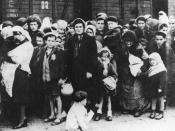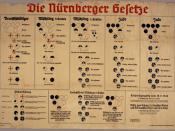One of the darkest events in the 20th century, the Holocaust, has been told again and again through all types of mediums. The history and events are rooted in the minds of anyone born in that span of 100 years. In Maus I and Maus II Art Spiegelman presents the story in a fresh new way. The style he uses and the way he chooses to portray the characters has been criticized and debated upon whether or not it is an appropriate way to describe such a tragedy. Spiegelman manages to combine several non-traditional elements to document his father's struggle; using the comic strip format and animals to represent the different races and nationalities while preserving the story's authenticity.
. When you think of a comic book you usually think of a heroic tale or something of fantasy. The Holocaust had no heroes, only villains and victims, but the story is so surreal that the comic format seems almost necessary to capture the scope of the tragedy.
The images and the dialog have a way of telling the story in a very direct way by illustrating an emotion in a 2 inch box.
By using the comic strip Spiegelman is able to make the transition from past to present very smooth and easy to understand. Art's father, Vladek, can go from talking directly to him to telling more of the story and it doesn't distract from the goal of the book. Spiegelman doesn't need to use date headings or even point out that we're going from the present to the past, or vice versa. The reader can see from the darker contrast in the drawings and details in the characters that they've gone back to Europe.
The comic strip format comes together in a story like this almost like it's...


